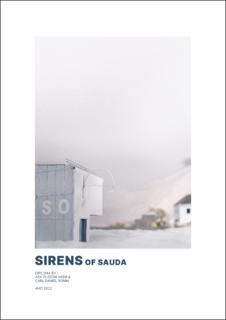| dc.contributor.advisor | Brandsdal, Martin | |
| dc.contributor.author | Romm, Carl Daniel | |
| dc.contributor.author | Aabø, Ask Olsson | |
| dc.coverage.spatial | Sauda, Rogaland, Vestland, Norway | en_US |
| dc.date.accessioned | 2023-02-21T08:08:21Z | |
| dc.date.available | 2023-02-21T08:08:21Z | |
| dc.date.issued | 2022-12 | |
| dc.identifier.uri | https://hdl.handle.net/11250/3052543 | |
| dc.description | Norwegian Scenic Route projects are high-end architectural interventions. Fundamentally free to use, the projects are intended to guide tourists along Norway’s designated scenic routes. They are also framing devices, deeming certain pieces of landscape to be more important than others. These projects become isolated nodes along a network on the scale of international tourism.
Sirens of Sauda is a Norwegian Scenic Route project that directly deals with the Norwegian small-town’s dwindling urban center. The free-to-use premise of The Scenic Route project is bridged with a potential to regenerate public spaces and social life by providing subtle leisure for both visitors and locals. The proposal draws a path through the urban landscape of Sauda, utilizing local stakeholders, infrastructure, myths and legends as a way to expand upon and strengthen existing local history, as well as anchoring the project in the complexity of Sauda’s urban life.
Instead of framing the landscape as a frozen relic, Sirens of Sauda aims to blend in, treating its surroundings as scenery in constant redevelopment. Visitors are invited to become a stitch in the social fabric for the duration of their stay, making their presence visible.
Sirens of Sauda is a series of five leisure buildings situated along ‘Rådhusgata’ in Sauda where it latches on to the Ryfylke Scenic Route at the end of ‘Rådhusplassen’. All projects are connected through district heating pipes serving surplus heat as well as electricity from the factory. Small extensions are made to the already existing pipe grid to highlight entrances, heat rooms and pool -water and melt snow. The projects are therefore not only connected by their placement along Rådhusgata but also by their shared use of free heat and electricity as a tool for space and experiences. The heated pipelines reintroduce the old country road that once went from the docks to the church. | en_US |
| dc.language.iso | eng | en_US |
| dc.publisher | The Oslo School of Architecture and Design | en_US |
| dc.rights | Navngivelse-Ikkekommersiell-DelPåSammeVilkår 4.0 Internasjonal | * |
| dc.rights.uri | http://creativecommons.org/licenses/by-nc-sa/4.0/deed.no | * |
| dc.subject | Architecture | en_US |
| dc.subject | Arkitektur | en_US |
| dc.subject | Byutvikling | en_US |
| dc.subject | Nasjonale turistveger | en_US |
| dc.title | Sirens of Sauda | en_US |
| dc.type | Master thesis | en_US |
| dc.description.version | submittedVersion | en_US |
| dc.rights.holder | Ask Olsson Aabø & Carl Daniel Romm | en_US |
| dc.subject.nsi | Architecture and design: 140 | en_US |


